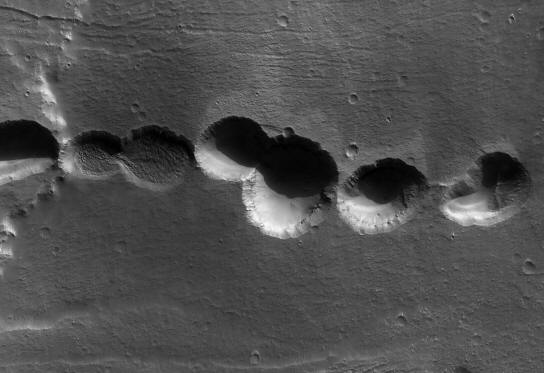|

A chain of electrically etched craters in the
Alba Terra region of Mars.
Credit: NASA/JPL/University of Arizona
Martian Electric Augers
Jun
07, 2010
The surface of Mars is
electrically eroded.
Editor's note: This Picture of the
Day will be slightly different. The
following image links require the
use of anaglyph glasses to see the
3D effect.
What caused the majority of
craters on Mars? From a consensus
perspective, the answer lies in one
of two ways: meteor or asteroid
impacts or the remains of volcanic
vents and caldera. From the
perspective of an electric Universe
paradigm however, the answer is
quite different and perhaps
difficult to accept: electric arc
discharges of enormous power.
Northwest of Hellas Basin
Lighting bolts are hollow,
rotating helices of plasma capable
of disintegrating the hardest stone.
In this image the rotational
component is readily apparent. Since
the majority of planetary scientists
would say that this structure was
created by a meteor crashing into
Mars, the question is: what kind of
explosion can carve the bottom of a
crater into multiple spiraling
bands?
North of the Tharsis "volcanoes"
When plasma discharges linger for
a moment before jumping to another
location, the intense heat generated
by the multimillion degree current
flow will excavate a crater, while
melting the material. An example of
the "pulling" effect that
electromagnetic fields have on the
surrounding terrain can be seen
here. Electrons are yanked towards
the center of the discharge channel,
ripping apart the rocks and dragging
the neutral material along with
them. The fused microscopic dust is
then sucked up into the center of
the vortex and ejected into space.
This explains why the bottoms of
many craters are smooth and flat,
with little or no blast debris.
Northeast of Olympus Mons
Around the largest "volcano" in
the Solar System is a network of
deep fractures that radiate from the
central mound for hundreds of
kilometers. Among those sharp-edged,
steep-walled chasms are several
craters with nearly identical
morphology, such as the one in this
image. When electricity passes
through a solid body, like as a
planet, it either erodes the surface
or deposits material at the strike
points. The craters are usually
circular because electric forces
cause the arcs to impact at right
angles. Since filaments of
electricity rotate, rock and dust is
drilled out, leaving steep sides and
"rolled" rims of melted debris.
Northwest of Elysium Mons
Concentric circles, central
peaks, and uplifted mounds dominate
the terrain in this image.
Conventional viewpoints are unable
to provide a satisfactory
explanation for why craters found on
Mars (and other Solar System bodies)
often display ridges around a common
center. As conventional theories
state, craters formed through
kinetic impact possess rounded
floors because explosions are
spherical. Blast debris is hurled
outward ballistically, creating a
radial pattern of material sorted
from coarse and heavy close by, to
fine and light farther away. Impact
energy dissipates through mechanical
shock, forcing the strata to flow
and then instantly freeze in place.
The process that produces these
mound and crater combinations is a
mystery to Mars researchers.
Southwest of the Tharsis region
Crescent-shaped discharges appear
to have carved the formations seen
here. The highest points are
embossed with the unmistakable sign
of electricity acting on a
conductive medium, Lichtenberg
figures. The moats that are dug
deeply into the surface also suggest
electrical activity, as do the
perpendicular ridges and granular
landscape covering hundreds of
square kilometers. The nubbins of
solid stone that align themselves in
crisscross patterns are reminiscent
of corona discharges that can
sometimes be seen at right angles to
a primary arc.
The features on Mars tell a story
that includes incredibly violent
events in the recent past when it
experienced powerful plasma
discharges on a massive scale. Vast
areas show signs of excavation down
to 10 kilometers below the mean
elevation of the planet. Some of the
shattered rock was accelerated
electrically into space; some fell
back to the surface, where it was
electrically sorted and deposited in
hardened layers.
Burned and blasted craters, piles
of scorched dust covering almost an
entire hemisphere, and great
trenches that wend across its
scarred face lead to the conclusion
that lightning thousands or millions
of times more energetic than we know
today devastated Mars. The existence
of these formations constitutes a
confirmation of the Electric
Universe hypothesis.
Stephen Smith
|







